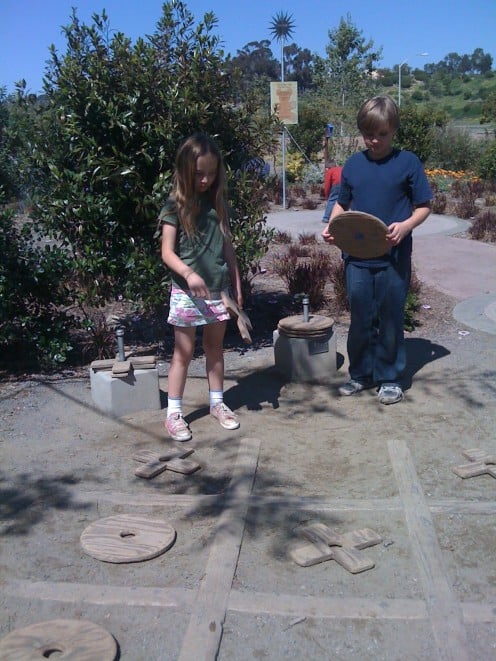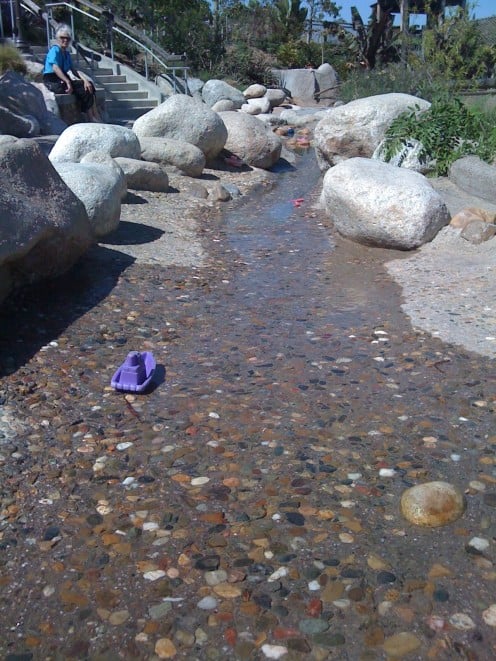A Child's Garden of Delight: Hamilton Children’s Garden at the San Diego Botanic Garden
Put down that iPad for a while; turn off the Wii and yank out those ear buds. Time for input of another kind, shared with your little ones who won’t always be little. Take the hands of your children and whisk them off to a corner of the world reserved for kids and their grown-ups who enjoy reliving the delights of childhood. Spend the day together discovering the wonders of the natural world in the San Diego Botanic Garden's children's gardens.

Hamilton Children's Garden
Located in Encinitas, California, 30 miles North of San Diego, The San Diego Botanic Garden (formerly known as the Quail Botanic Garden) boasts not just one, but two separate children's gardens within their 37 acres. The Seeds of Wonder Children's Garden is designed primarily for preschoolers, and has long been a fixture in the Botanic Garden. The second children's garden, designed to welcome all ages, is the delightful Hamilton Children's Garden.
Opened in June of 2009, the Hamilton Children’s Garden is heralded as the largest interactive children's garden on the West Coast of the United States. This kids' garden offers a kaleidoscope of fun and interesting interactions with the natural world, presented through several garden stations.
Children can flit between these themed stations, encountering nature through various perspectives. Crossing the giant compass in the ground and heading west into the garden, one of the first themed stations colorfully announces its theme with bright letters. It's the Spell and Smell garden, where kids take themselves on an A-B-C tour through the alphabet as represented by plants. "C" is for Chocolate Mint, and kids smile when they learn there really is a plant that smells like mint chip ice cream! "N" is for Nasturtiums, vibrant orange blossoms that (surprise!) you can eat. Little ones tend to linger at each letter station, sating their curiosity about each representational plant. It's a healthy change from the rushed pace of hectic input so common today.

Across from the Smell and Spell Garden is the Interactive Sundial. Instead of just staring at a shadow-casting sculpture, kids use a teddy bear pulley and line to actively participate in setting the sundial's time correctly. Remember to adjust your reading of the device for daylight savings time, as sundials neither spring forward nor fall back!
The Arts Garden
What could be more natural than exploring plein air art? Kids discover natural structure and the techniques of using pressure, direction and color in creating leaf rubbings with crayon at one station. Giant blackboards invite children to express themselves in the medium of chalk (a natural substance itself), and children spontaneously create plays and act out stories in the nearby playhouse that can serve as a fortress, space ship, princess castle or anything else children declare it to be.
Getting Down and Dirty
Instead of plying them with electronic gadgets, tell your kids to go play in the dirt. The Earth Builders area is a section of sandy soil with a handy water source nearby so kids can make all the mud pies they like. They can then "bake" their creations in a large stone oven powered solely by kids' imaginations. Plastic pails and shovels dot the area for digging tunnels, making sandcastles and creating roadways for little trucks to rumble over.
Where Go the Boats?

When they're done digging in the dirt, lead them next-door to the Mountain Meander. Kids can splash and play in this little stream of running water, and toy boats are provided for impromptu races. Of course, small fallen leaves can become great sailing vessels, and the Meander provides a great opportunity for a nice game of Pooh Sticks.
Towering Tree House
By far, the most prominent feature in the Hamilton Children's Garden is Toni's Tree House. A man-made tree dotted with live plants that will grow to provide fullness and a lush, living canopy, this 20-foot tall structure is one tree you'll want to encourage your kids to climb, although they likely won't require any encouragement at all. Set upon a soft, spongy artificial mulch pad for safety, this tree beckons kids to come explore, from its root tunnels to its elevated levels up in the sky.

Kids enter by crawling through and climbing over a maze of roots, while curious adults can opt for the simpler and less obstructed walk-through passage on the other side. A spiral staircase leads explorers up, up, up through the branches and deposits them in the Buzzard's Roost, the covered lookout tower atop the structure. From here, those who brave crossing a span of woven rope bridge will be rewarded with a bird's eye view of the garden from an extended outlook. Balance-testing sectional plank bridges, rope ladders and more entice physical activity with the promise of adventure and discovery. When your children emerge from the tree, ask whether they found the tree's secret hideout.
While kids scamper through the tree house, other party members may enjoy relaxing on the shaded fabricated rock ledges nearby, taking in the cheerful sounds of children's squeals of laughter.
Making Music with Nature
Children are naturally filled with music. There's no need to have mastered an instrument when there are rocks and sticks around. The Garden Rhythms section of the Hamilton Children's Garden offers kids the opportunity to express themselves musically through unusual percussion instruments. Slowly turn the rainstick to pour out gentle rattling sounds through the station. Sections of bamboo in various lengths are suspended on a long rack stretching across a corner of this station. Knocking these bamboo chimes against one another creates a ripple of click-clacking sounds, and kids enjoy working together on this instrument to produce a cacophony of sound. A carved wooden animal with a spiny backbone and mouth agape, stands alone upon a table. Kids rub the back of this animal with a wooden stick, and sound not unlike a frog's "ribbit" emanates from its mouth.
One of the most unusual and delightful finds in this garden, for any age, is the spectacular lithophone. This is a slate marimba, created by prehispanic musician Martin Espino, who constructs and performs on indigenous instruments originating from ancient Mexico and other parts of the ancient Americas. The stones in the lithophone are carved and chiseled just so, such that each stone produces a particular note when struck with a wooden mallet. Assembled together, these rocks form a stone xylophone that produces curiously surprising and unexpected chime-like sounds that emanate throughout the garden.
Listen to a Lithophone
This lithopone, like the one at the Hamilton Children's Garden, is made of natural stone. Find out more about stone xylophones at Lithophones.com.
Stop Reading and Start Exploring
There's more to the Hamilton Children's Garden--the Elephant Foot Tree Forest, for example, and the Incredible Edibles garden--but these are all best experienced in person with your children. Breathe in the scents of fresh flowers and fragrant herbs; listen to gurgling waters; watch as the sunlight dances on the ripples caused by a three-year-old dropping a leaf into a fountain; engage with your children as they explore and interact with the call of nature, and relive the wonder of discovery through their eyes.
Text and Photos © M.S. Ross - All Rights Reserved
Is there a children's garden you particularly enjoy? Where is it located, and what are your favorite features about it? Share your experiences in the comments section below.
Learn More!
- San Diego Botanic Garden - Located North of San Diego in Encinitas, California
Formerly known as the Quail Botanic Garden, the San Diego Botanic Garden boasts two children's gardens. - Lithophones.com | Home
Learn about lithophones and listen to examples of actual lithophones being played by various musicians. Amazing variety of sounds!








